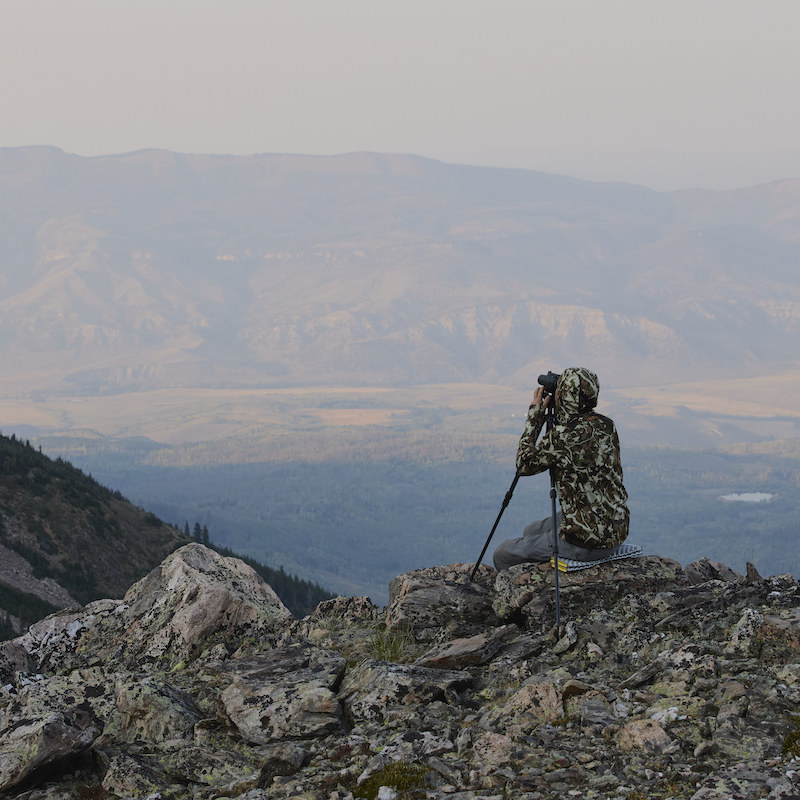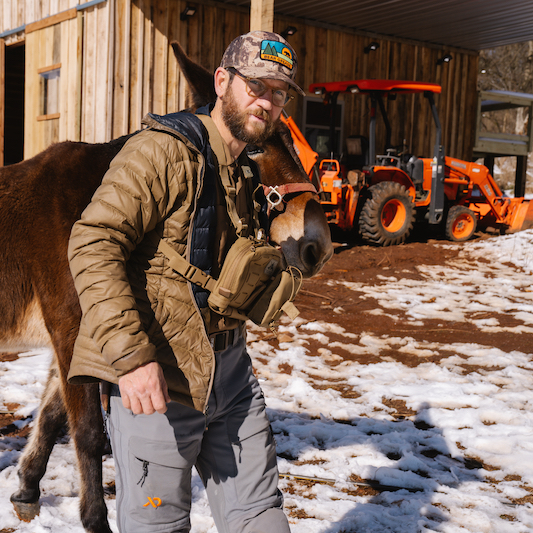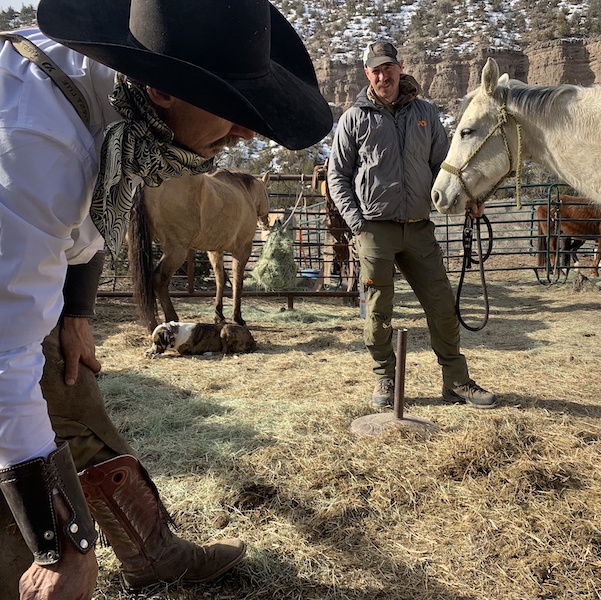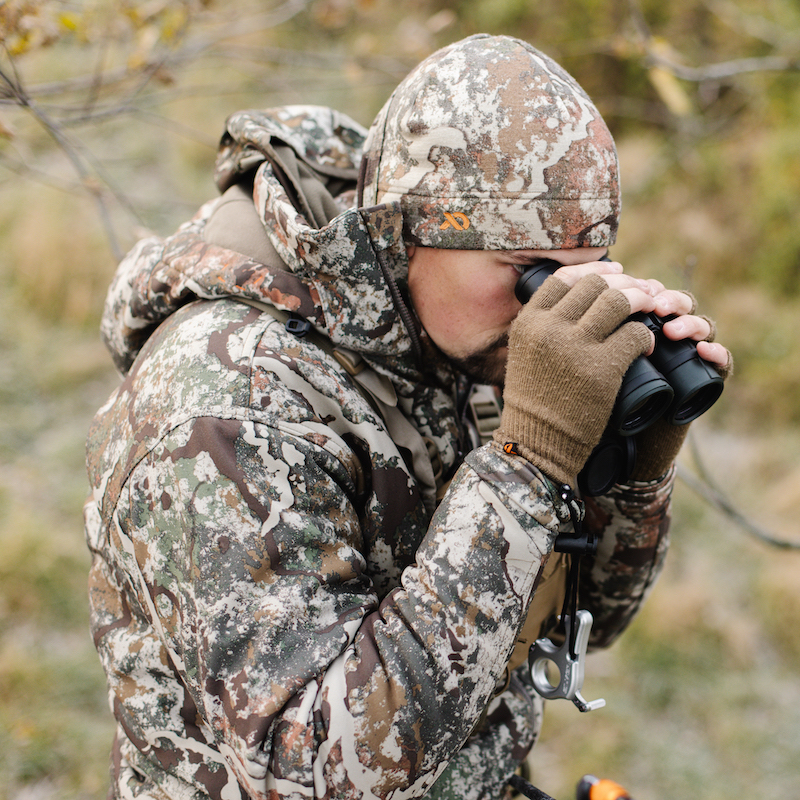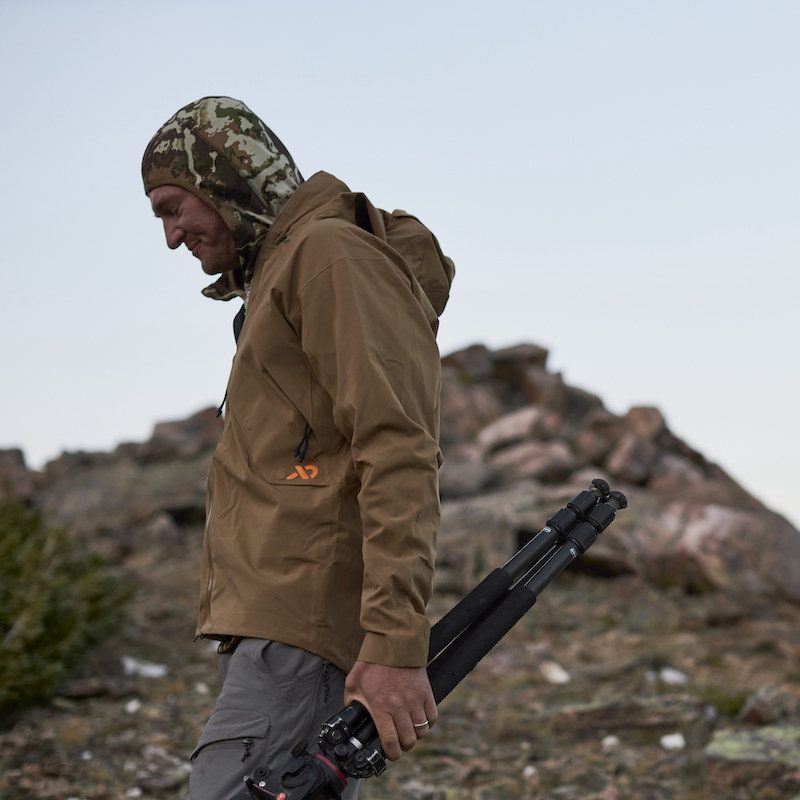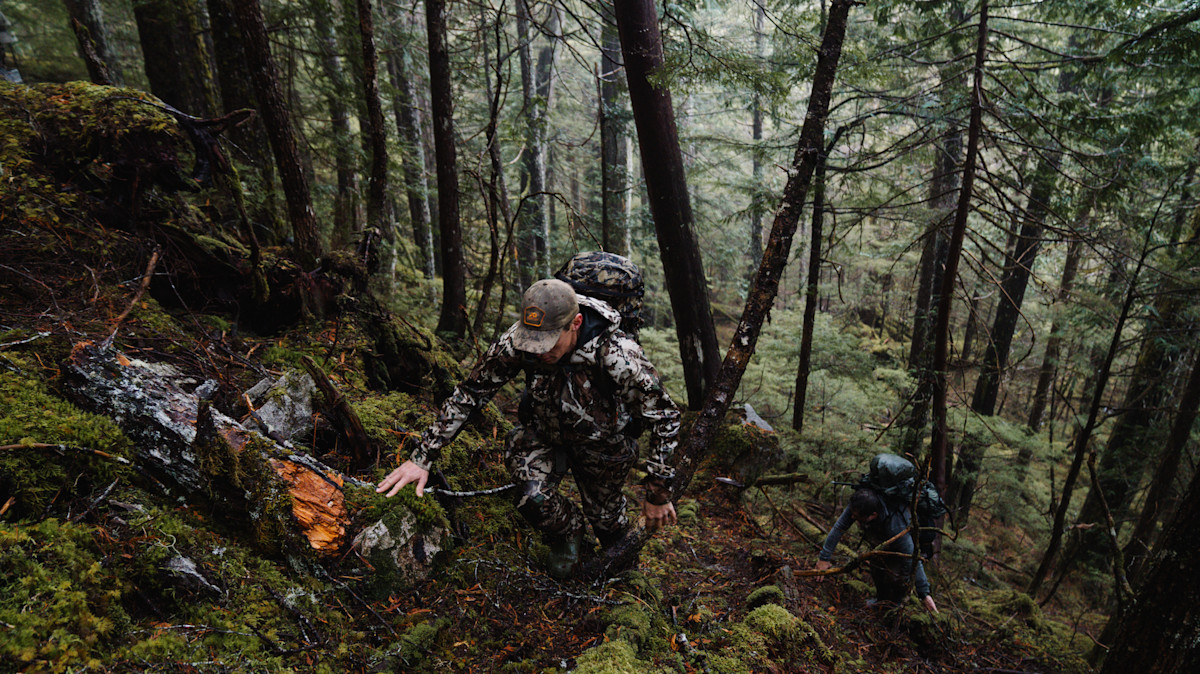
Along with hunting pants, jackets are the other cornerstone of a gear system. Your jacket does the most work to keep your core insulated. It can also provide important wind and moisture protection for your torso, as well as useful pockets for storing gear or un-numbing fingers.
Some jackets are very simple, but many of the best ones specifically designed for hunting have come to contain useful features such as hoods, masks, vents, oversized pockets, tree stand safety harness pass-throughs, ergonomic designs, and more. Many of these items can make your average day in the woods more comfortable, efficient, and fun.
Jump to: Hunting Jackets We Use
What We Look for in Good Hunting Jackets
The parka you wear in the late November deer stand or January goose blind might actually come in handy at the opener of turkey season. It did for me this year. With that said, it will likely become a lot less practical by closing day. But, if you purchase and dress properly, the mid-layer hoody, sweater, or jacket you wore under that heavy coat can become the outer layer once the day or the season warms up. The qualities we look for in a good hunting jacket are:
- Temperature Range
- Breathability
- Versatility
- Features
Jump to: What Makes A Good Hunting Jacket
Hunting Jackets We Use
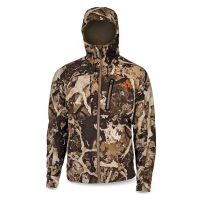 First Lite Catalyst Soft Shell Jacket
Steve's Pick
|
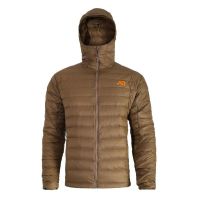 First Lite Brooks Down Sweater
Clay's Pick
|
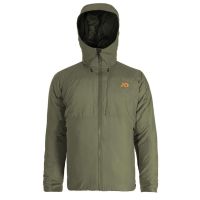 First Lite Uncompahgre 2.0 Puffy Jacket
Cal's Pick
|
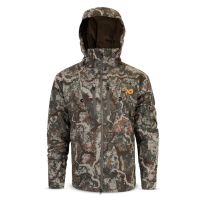 First Lite Solitude Jacket
Mark's Pick
|
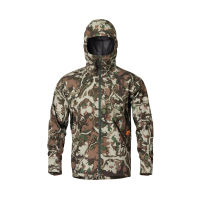 First Lite Omen Stormshelter Jacket
Sam's Pick
|
|
|---|---|---|---|---|---|
| Best For | Fall, Winter, Spring | All Seasons | All Seasons | Fall, Winter, Spring | Rain |
| Weight | 19 oz. | 10.9 oz. | 20 oz. | 49.5 oz. | 26 oz. |
| Temperature Range | 20-60°F | 20-60°F | 20-60°F | 0-45°F | 20-60°F |
| Materials | Soft shell exterior, interior fleece lining | Treated nylon over down | DWR exterior, synthetic insulation | Silent 2 layer exterior, synthetic insulation | 4.5-Layer Rain Shell |
| Price | $240 | $275 | $220 | $300 | $400 |
| Field Notes | Field Notes | Field Notes | Field Notes | Field Notes |
What Makes a Good Hunting Jacket
These are the primary factors we consider when packing or purchasing a hunting jacket.
1. Temperature Range
I don’t mean to tell anyone how to dress; I’m sure your mother did that a long time ago. But I’ve seen enough hunters make bad clothing choices over the years that it feels worth mentioning that you should pull on or bring a jacket suited for the conditions at the outset of your hunt as well as the conditions you might encounter. It’s a common mistake to walk out on a sunny afternoon in a light jacket, only to get shivery once the sun dips low. Similarly, plenty of folks have braved a frigid morning in a thick coat, only to wish they’d brough a lighter option that still offers some warmth for later in the day. When choosing a jacket, keep such considerations in mind. It may be helpful to visualize the temperature range of an average day when and where you hunt. How warm could it get? How cold? Think about how this jacket fits into your broader gear kit to keep you comfortable all day.
2. Breathability
Do you typically walk a few hundred yards to sit in your turkey blind, or are you headed 2,000 feet up into the crags to glass the whole basin for black bears? Most modern hunting jackets breathe better than those of the past, but today’s offerings are still designed with a purpose in mind. Some are oriented toward sitting on stand and maintaining warmth while others will shed your excess body heat as you hike.
3. Versatility
It’s always nice to use one piece of gear for multiple applications, right? Some of our hunting jackets see use on spring bear and turkey hunts, fall elk and deer trips, winter waterfowl and ice angling, and even chilly summer nights of camping and fly fishing. Some of the best jackets and sweaters serve as a mid-layer when it’s cold and an outer layer when it’s temperate.
4. Features
Some folks can’t stand hoods; others can’t live without them. The features that appeal to us as hunters have a lot to do with personal preference and hunting style. A built-in face mask is awesome if you like to bowhunt gobblers or bulls up close, but may be less useful to the long-range rifle hunter. If you’re not hiking long distances, zippered vents may not be practical. They’re basically mandatory for certain hunts though. Consider pocket placement and number in regard to the amount of gear you normally need to stash, as well as whether you’re going to be wearing a backpack, tree stand safety rig, and/or binocular harness.
Field Notes from the MeatEater Crew
We could talk for hours about each piece of gear in our kits, and we know a lot of you love the details. We've summarized the key specs below along with comments from the crew.
Steve's Pick
Versatile and Comfortable
Few people get to hunt as often or in more diverse landscapes than MeatEater Founder Steven Rinella. In order to create everyone's favorite hunting show, he's often bouncing from Texas to Maryland to Alaska to Mexico (for example) in the span of a month. The clothing he takes on every one of those trips speaks highly to that gear's efficacy and versatility.
"What I like for a go-to grab jacket is the Catalyst," Steve said. "I wear that thing all the time. I like it because it has stretch, durability, and freedom of movement. Top to bottom and side to side, this thing has been everywhere in the country. I love it, always grab it, it’s such a great piece of hunting apparel."
Specifications
- Weight: 19 oz.
- Temperature Range: 20-60F
- Pockets: Two hand pockets, two chest pockets
- Features: Stretchy, quiet, water-resistant, and wind-proof.
- Materials: Soft shell exterior, interior fleece lining
- Price: $240
Clay's Pick
Light and Warm
Down jackets enjoyed a renaissance in the outdoors world some 10 to 15 years ago. Unlike the overstuffed Michelin Man suits of generations past, modern down jackets are breathable, comfortable, and light as air. Always a student of history, Clay Newcomb appreciates the classic goose down construction and slightly retro styling of First Lite’s midweight Brooks Sweater.
“Season to season, I use my Brooks Down Sweater more than any other piece,” Clay said. “It’s very comfortable and easy to layer underneath to accommodate the temperatures. I absolutely love it.”
Specifications
- Weight: 10.9 oz.
- Temperature Range: 20-60F
- Pockets: Two hand warming pockets
- Features: Advanced downproof, the nylon shell repels snow/rain and blocks wind
- Materials: Treated nylon over down
- Price: $275
Cal's Pick
Uncompromising Warmth
The Uncompahgre National Forest spans nearly a million acres of steep mountains and high alpine country in southwestern Colorado. This jacket was meant to reflect that ruggedness and the highly varied conditions those peaks provide. The synthetic insulation creates a perfect microclimate that keeps you warm while sitting and cool while hiking. The treated exterior sheds water better than most other jackets like it, and the ergonomic sleeves and hood provide the range of motion and field of view that serious mountain hunters require. Ryan Callaghan says he uses it for bears, turkeys, trout, walleye, and whatever else he might get into this season.
“The Uncompahgre Puffy is a key outerwear and layering piece for my hunting set up,” Cal said. “It's a great insulator but it also sheds water well and holds up to tears.”
Specifications
- Weight: 20 oz.
- Temperature Range: 20-60F
- Pockets: Three, one for packing coat into itself
- Features: Biomechanically correct shooter's cut sleeves, shoulders, and hood
- Materials: DWR exterior, 37.5 Synthetic insulation interior
- Price: $220
Mark's Pick
Whitetail to Turkey
The deer season just doesn’t ever really end for some people. Turkey and other spring hunting opportunities are merely chances for these folks to hone their skills, learn new country, and pick up whitetail sheds. Their purchasing decisions too lean heavily toward the rut. Mark Kenyon and his ilk often end up using a lot of their whitetail gear system out in the spring if for no other reason than they’re comfortable with it. But the Solitude Jacket is about as good as it gets for a cold day in the turkey blind, just like the tree stand.
“It’s got that nice quiet but tough exterior face, it has the 37.5 insulation, it’s going to keep you nice and toasty,” Mark said. “Smart pockets, there’s the chest pocket and side zips. It’s just perfect for what I need.”
Specifications
- Weight: 49.4 oz.
- Temperature Range: 0-45F
- Pockets: Two insulated hand pockets, two Napoleon storage pockets
- Features: Silent fabric, zippered pass-through for safety harness and bib muff
- Materials: Silent, brushed 2-layer Catalyst Soft Shell exterior, 37.5 Synthetic insulation interior
- Price: $300
Sam's Pick
Impermeable Sanctuary
I grew up hunting in Western Washington where rain isn’t a possibility, it’s an expectation. The thin, ultra-light, super packable rain jackets hunters from other regions keep stuffed in their packs all season do not cut it in the rainforest. You need a rain jacket you can live in, keeping you dry and comfortable for days on end.
That’s what First Lite was aiming for with their brand-new Omen Stormshelter Jacket. I once tested mine by getting sprayed with a garden hose, and my T-shirt didn’t show a drop of water. Out in the field, it evokes the feeling of armor, a sense that you won’t get hypothermic no matter how hard it blows or snows. The 4.5-layer rain shell lets heat out without water getting in, assisted by the groundbreaking new heat vent zips across the chest and shoulders rather than inconveniently under the arms. The durable face fabric is rugged without being bulky, allowing you to smash through devil’s club and Russian olive and whatever other evil briars you may come across. I’ve tried a lot of rainwear and this is as good as it gets.
Specifications
- Weight: 26 oz.
- Temperature Range: 20-60F
- Pockets: Two large magnetic dump pockets
- Features: Cowl chest and shoulder vents, 3-way adjustable hood with fold-back brim, flat-seal cuffs
- Materials: 4.5-Layer Rain Shell
- Price: $400

